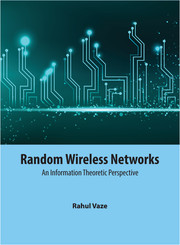Book contents
- Frontmatter
- Dedication
- Contents
- List of Figures
- Preface
- Acknowledgments
- Notation
- 1 Introduction
- 2 Transmission Capacity of ad hoc Networks
- 3 Multiple Antennas
- 4 Two-Way Networks
- 5 Performance Analysis of Cellular Networks
- 6 Delay Normalized Transmission Capacity
- 7 Percolation Theory
- 8 Percolation and Connectivity in Wireless Networks
- 9 Throughput Capacity
- Index
- References
3 - Multiple Antennas
Published online by Cambridge University Press: 05 May 2015
- Frontmatter
- Dedication
- Contents
- List of Figures
- Preface
- Acknowledgments
- Notation
- 1 Introduction
- 2 Transmission Capacity of ad hoc Networks
- 3 Multiple Antennas
- 4 Two-Way Networks
- 5 Performance Analysis of Cellular Networks
- 6 Delay Normalized Transmission Capacity
- 7 Percolation Theory
- 8 Percolation and Connectivity in Wireless Networks
- 9 Throughput Capacity
- Index
- References
Summary
Introduction
In this chapter, we address an important question on the optimal role of multiple antennas in a wireless network. For a point-to-point channel with no interference, from Chapter 1, we know that employing multiple antennas at both the transmitter and the receiver either linearly increases the capacity or exponentially decreases the error rate with SNR. In contrast, in a wireless network, where interference is the performance limiter, finding how to best use the multiple antennas is a fairly complicated issue.
The problem is challenging because in the presence of interference, multiple antennas have dual roles at both the transmitter and the receiver side. On the transmitter side, multiple antennas can be used to beamform the signal toward the intended receiver or to suppress transmission (construed as interference) toward other receivers. Similarly, on the receiver side, each receiver can use its multiple antennas to improve the SNR from its intended transmitter or cancel the interference coming from other transmitters. To further compound the problem, the roles of multiple antennas at both the transmitter and the receiver side are inter-dependent on each other.
In this chapter, we derive results on the scaling of the transmission capacity with the number of antennas for two cases; i) CSIR case, where only the receivers have channel coefficient/state information (CSI), and ii) CSIT case, where in addition to CSIR, each transmitter also has CSI for its intended receiver. We derive upper and lower bounds on the transmission capacity with multiple antennas that do not match each other exactly but have a negligible gap for path-loss exponent values close to 2.
We show that with linear decoders, for example, zero-forcing (ZF) or minimum mean square error (MMSE), the transmission capacity scales at least linearly with the number of antennas for both the CSIR and the CSIT case, and sending only one data stream from each transmitter achieves the linear scaling of the transmission capacity in both cases.
- Type
- Chapter
- Information
- Random Wireless NetworksAn Information Theoretic Perspective, pp. 43 - 79Publisher: Cambridge University PressPrint publication year: 2015



